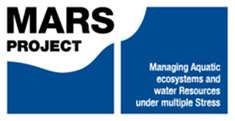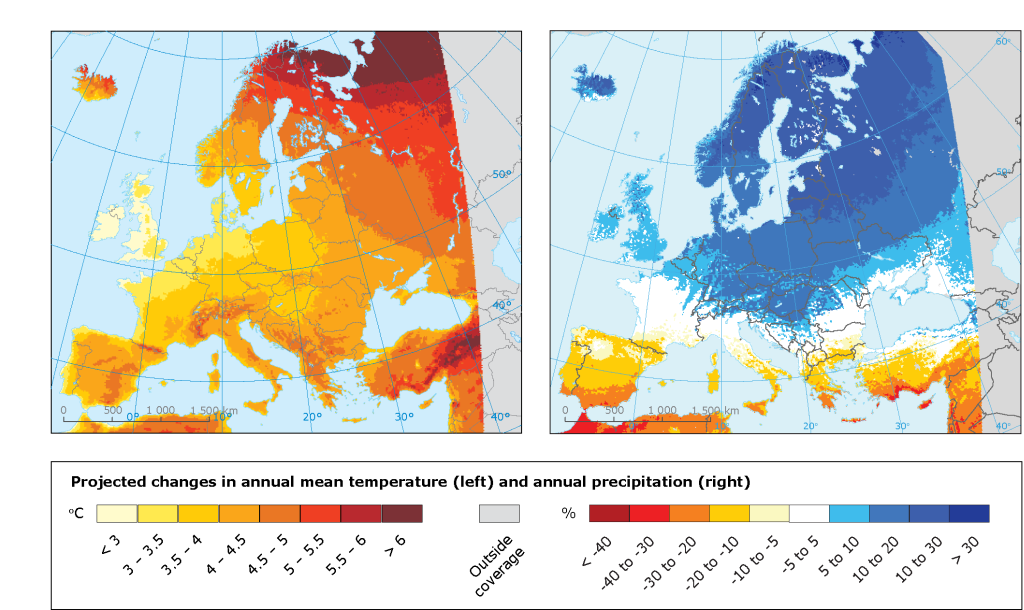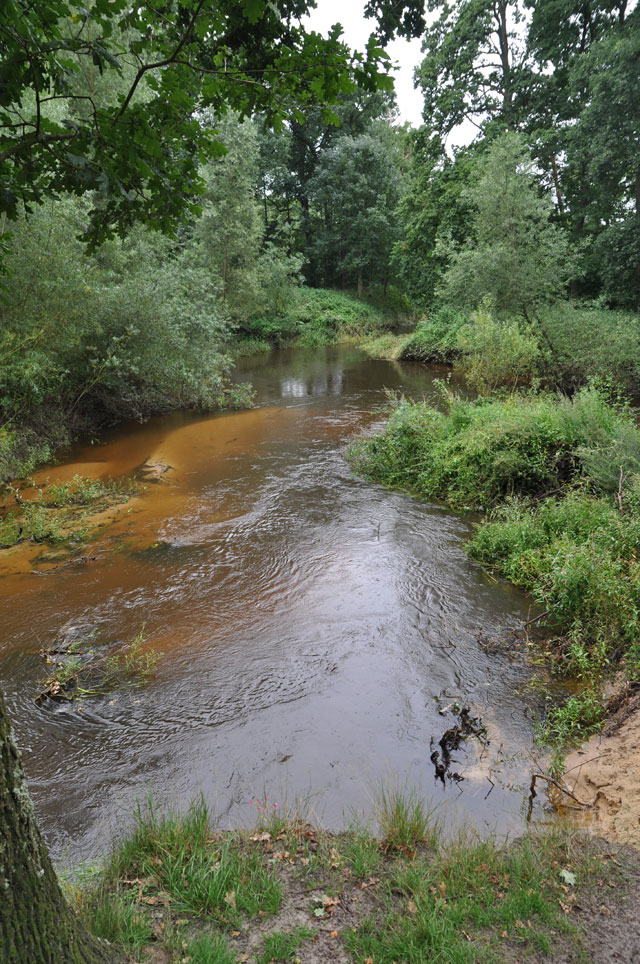Climate Change
The global climate system and hydrological cycle are intricately interconnected. This means that ongoing changes to Earth’s climate are a key influencing factor on the health and status of European water bodies, the biodiversity they support and the ecosystem services they provide.
Climate models and predictions suggest that, across a range of possible scenarios, we can expect climate change to have significant impacts on European freshwaters over coming decades, primarily in the form of increasing air and water temperatures, changes in seasonal precipitation patterns and thus river flow, increased and more severe flood and drought occurrences, all resulting in reduced water quality and biodiversity (EEA 2016). Evidence suggests that over recent decades, we have already begun to see the impacts of climate change (IPCC 2014a, EEA 2015a).

Flooding of a little village because of high water levels in the river Rhine

Low water levels in a river caused by extreme climate events
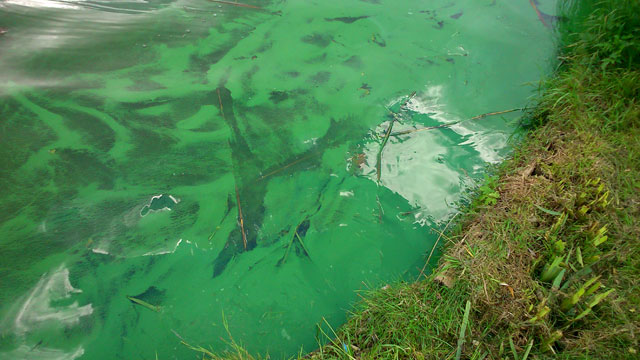
Algae blooms in Abcoudermeer (The Netherlands)
Climate Change pressures
Hydrological alteration
Increased variability in river discharge: Climate change is predicted to lead to a greater variability of precipitation patterns influencing discharge volumes in European rivers, both across regions and the seasons. Evidence suggests that river flows have increased in winter and decreased in summer in most European catchments, and that this trend will intensify into the future (EEA 2012a), with decreases most severe in the already water-stressed regions in the south and southeast (EEA 2012b).
Larger and more frequent droughts and floods: Drought and flood occurrences are expected to become more frequent and more intense under the influence of anthropogenic climate change. Drought and reduced summer water flows can have a serious detrimental effect on freshwater ecosystems, through the destruction of habitats, eutrophication, and reductions in the potential for dilution of pollutants. Floods can alter the sediment and nutrient load of rivers as well as their course and channel pattern. Since 1980, more than 325 major European river floods have been reported, and IPCC projections suggest that increasing extreme rainfall events will increase flood risk in the future under climatic changes (EM-DAT 2012, IPCC 2014b). The occurrence of droughts increased steadily between 1971 and 2011, not just in Southern but also Central, Eastern and Northern Europe (EEA 2012c).
Change in thermal, mixing or ice regime
Increased water temperature: Most aquatic organisms thrive in a limited range of water temperatures, so temperature is an important parameter of ecosystem health and status. The surface temperatures of European rivers have, on average, increased by 1–3 °C over the last century (EEA 2016). Increasing water temperatures lead to changes in life-cycle and survival rate of aquatic species, as for example warmer water can hold less dissolved oxygen, potentially leading to ‘hypoxic’ conditions. Warmer waters expand the range of some species, and limit the range of others, with many species moving northward (EEA 2016). Changing water temperature can thus facilitate the movement of invasive species (EEA 2016).
Algal blooms and eutrophication: The combination of increased water temperatures in ecosystems exposed to nutrient loads can increase the incidence of cyanobacteria blooms and eutrophication, reducing water quality. In several European lakes, algal blooms now occur one month earlier than they did in 1970s and 1980s, which can create the conditions for a trophic mismatch between algae and other species which depend on them for food (EEA 2012a).
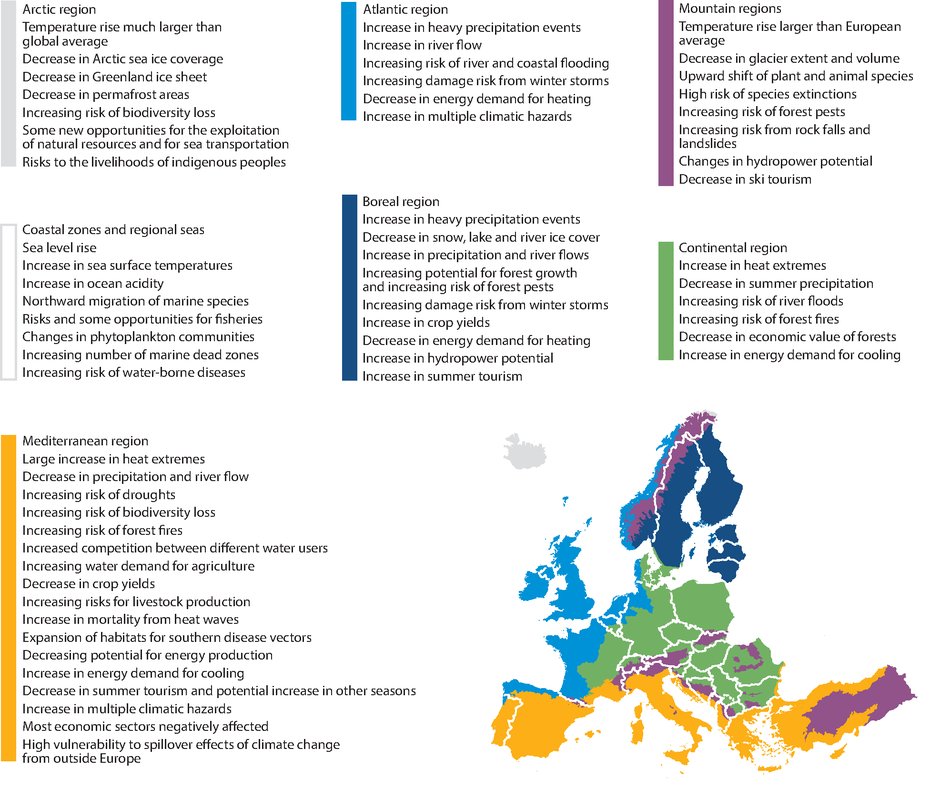
Geographical distribution of observed and projected impacts from climate change across Europe (EEA 2016)
Geographical distributions and trends
Over the course of this century, climate change is predicted to raise average temperatures in Europe by up to 5.5°C, with European temperatures increasing more than the global mean (IPCC 2014b). The amount of water in river catchments in northern regions of Europe is forecasted to increase, although some summer flows may decrease. Southern and south-eastern regions are expected to experience reduced water flows and increased drought as temperatures increase (EEA 2016).
Annual river flow in Europe since the 1960s has decreased in Southern and Eastern Europe, and increased in other places. A reduction in snow accumulation due to warmer winter temperatures is projected to reduce springtime snow-melt flooding in north-eastern Europe and the Alpine and Carpathian regions (EEA 2016).
Potential for 'water friendly' mitigation
Broadly, the rapid trajectories of anthropogenic climate changes can only be mitigated by significant global reductions in fossil fuel emissions from energy production, industry, agriculture and urban developments. A key strategy for increasing the resilience of freshwater ecosystems are climate change adaptation strategies (see e.g. FP7 project BASE, Circle2 2012). The protection and restoration of riparian woodland and vegetation has been shown to help control temperature extremes in water bodies through shading, especially in smaller streams (REFRESH 2014).
Similarly, natural water retention methods such as the restoration of natural river courses and flows, wetlands and flood plains can help maintain sufficient ecological flows through catchments, and buffer against extremes of rainfall and water temperatures (EU 2012c). A key concern for mitigating the effects of thermal pressures from climate change is to prevent water bodies from crossing ‘tipping point’ thresholds (e.g. in a warming, algae-dominated lake) to new ecological regimes which are difficult to restore (REFRESH 2010).
The uncertainty inherent to climate change means that future management of freshwaters should, in the face of a changing climate, be adaptive. The Water Framework Directive’s River Basin Management planning process is cyclical, allowing policy makers and practitioners to react appropriately to new scientific knowledge and unexpected impacts of the changing climate. Updated River Basin Management Plans should thus anticipate on the foreseen consequences of climate changes and adapt the Programmes of Measures to build resilience. Guidance has been provided to ensure that practitioners can best manage river basins in a changing climate (EC 2009).
Further reading
Reports:
CICLE-2 (2012). Adaptation Inspiration Book - 22 implemented cases of local climate change adaptation to inspire European citizens (Download report, 55mb)
EC (2009). WFD CIS Guidance Document No. 24: River basin management in a changing climate (Download report, 1mb)
EEA (2012a). Climate Change, Impacts and Vulnerability in Europe, Report No 12/2012 (Download report, 31mb)
EEA (2012b). European waters - assessment of status and pressures (Download report, 28mb)
EEA (2012c). European waters - current status and future challenges - Synthesis (Download report, 6mb)
EEA (2015a). European briefings Climate change impacts and adaptation (Download report, 564kb)
EEA (2015b). Map - Projected changes in annual mean temperature and annual precipitation (Download report, 222kb)
EEA (2016). Key findings - Climate change, impacts and vulnerability in Europe 2016 (Download report, 466kb)
IPPC (2014a). Climate Change 2014: Synthesis Report – Summary for Policymakers (Download report, 3mb)
IPPC (2014b). Climate Change 2014: Impacts, Adaptation, and Vulnerability. Part B: Regional Aspects. Contribution of Working Group II to the Fifth Assessment Report of the Intergovernmental Panel on Climate Change (Download report, 12mb)
REFRESH (2014). Science Policy Brief - Riparian Forest can help mitigate climate warming effects in lowland temperature streams (Download report, 200kb)
Selected Freshwater blogs:
Freshwaterblog (2014).What we talk about when we talk about uncertainty (External website)
Freshwaterblog (2015a). Water and Climate Change at COP21 in Paris (External website)
Freshwaterblog (2015b). Extreme events in running waters (External website)
Websites
BASE FP7 project - Bottom-up Climate Adaptation Strategies Towards a Sustainable Europe (External website)
CICLE-2 FP7 project - Climate Impact Research & Response Coordination for a Larger Europe (External website)
EM-DAT (2012). The International Disaster Database, Centre for Research on Epidemiology of Disasters (CRED) (External website)
REFRESH FP7 project - Adaptive Strategies to Mitigate the Impacts of Climate Change on European Freshwater Ecosystems (External website)
